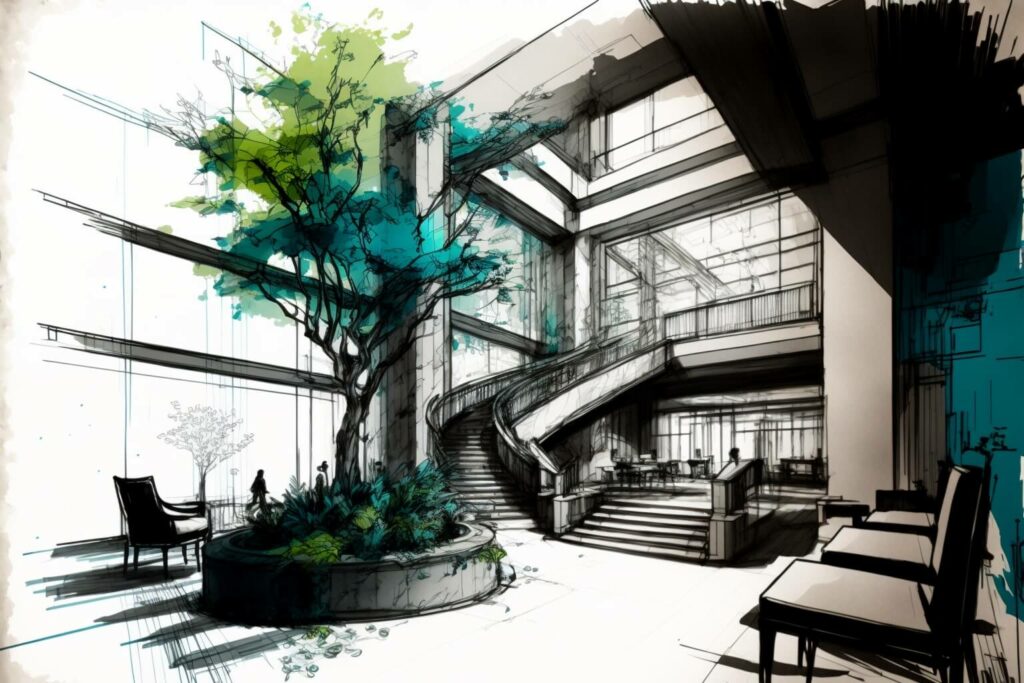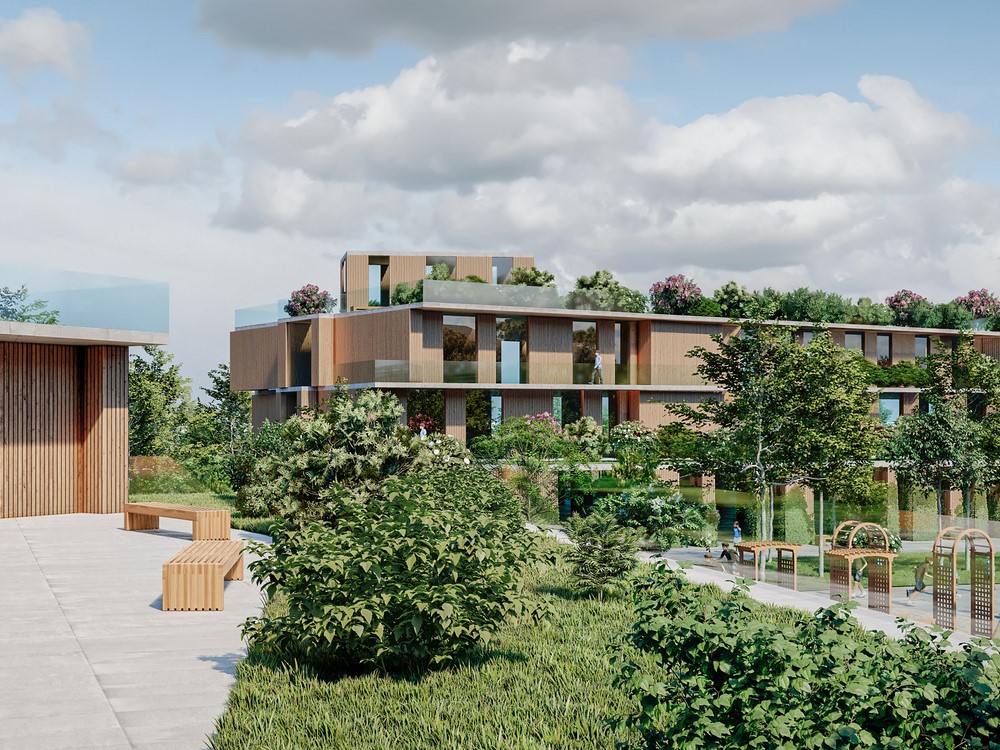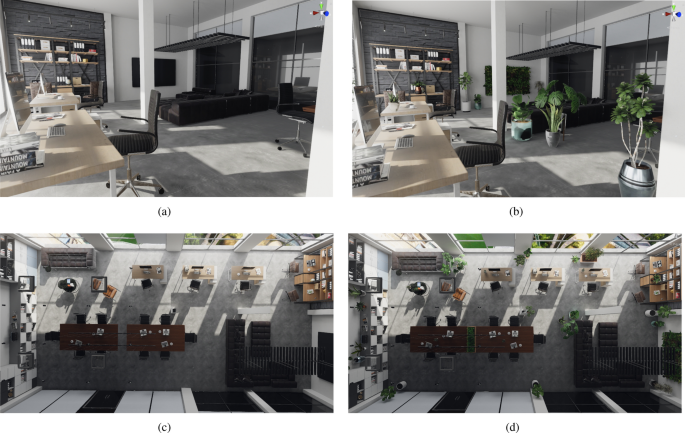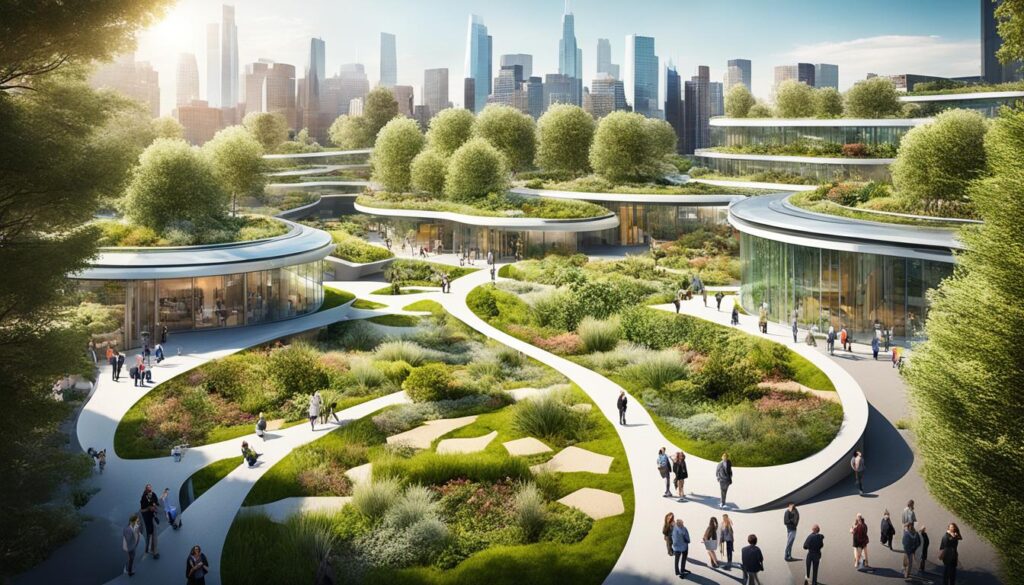The Future of Digital and Physical Integration in Biophilic Design.
Biophilic design is transforming the way individuals engage with their environments by integrating natural elements with modern technology to create spaces that promote both physical and mental well-being, embodying principles of nature-inspired design and wellness architecture.
This article examines the key principles of biophilic design, emphasizing its importance in fostering wellness and sustainability. It also explores how digital technology can enhance these designs while addressing the challenges associated with digital integration and the integration of physical and digital components in creating adaptive spaces.
By presenting inspiring examples from around the world and considering future developments, this exploration encourages readers to envision spaces that seamlessly harmonize nature and innovation, embodying the essence of design sustainability and ecological design.
The Concept of Biophilic Design
.jpg_00.jpeg)
Biophilic design represents an innovative approach to architecture and urban planning that emphasizes the intrinsic connection between humans and nature, with the objective of enhancing health and well-being within built environments through the principles of environmental psychology and biophilia.
By incorporating natural elements and fostering a connection to nature, this design philosophy promotes a more sustainable architectural practice that benefits both individuals and the environment, contributing to the concepts of ecological footprint and sustainable development.
As the significance of emotional well-being and the relationship with the outdoors becomes increasingly acknowledged, biophilic design emerges as a vital component of contemporary design trends and serves as a holistic approach to enhancing user experience through nature connectivity and wellness design.
What Are the Principles of Biophilic Design?
The principles of biophilic design encompass a range of strategies aimed at enhancing the connection to nature, a factor that is essential for fostering emotional well-being and promoting sustainable practices within various environments, highlighting the role of behavioral design and human-centered design.
By incorporating elements such as natural light, organic shapes, and green spaces into architectural and interior design, it is possible to create more inviting and restorative environments, which align with sustainable architecture and promote visual comfort. For example, the inclusion of large windows allows natural light to permeate a room, which can lead to improved mood and productivity. Similarly, utilizing curved lines in furniture and architectural design can replicate natural forms, thereby making spaces feel more organic and comforting.
In the realm of urban planning, the creation of green spaces not only enhances aesthetic appeal but also provides areas for recreation and relaxation, contributing positively to the overall health of the community and serving as integral components of urban ecology and place-making.
These principles are applicable not only to residential and commercial spaces but can also transform healthcare facilities, educational institutions, and public spaces into environments that foster both physical and mental well-being, showcasing the potential of design innovation and adaptive architecture.
Why Is Biophilic Design Important?
Biophilic design is essential as it not only enhances user experience by creating more inviting and livable spaces but also significantly contributes to health-focused design and environmental sustainability, integrating principles of design for the future and sustainable development. This approach leverages humanity’s intrinsic connection to nature, fostering environments that are not only visually appealing but also psychologically supportive, embodying concepts of wellness architecture and human experience.
Research indicates that the incorporation of natural elements, such as plants and natural light, can result in a 15% increase in productivity within workspaces, underlining the health benefits and productivity gains associated with biophilic elements. Environments designed according to these principles have been linked to a 30% reduction in stress levels among occupants, highlighting the direct correlation between design and wellness.
As urban areas encounter increasing climate challenges, biophilic design also bolsters resilience by promoting sustainable practices, such as enhanced air quality and decreased energy consumption, which align with principles of ecological integration and responsive architecture. Consequently, it serves as a critical component for the future of architecture.
The Integration of Digital and Physical Elements in Biophilic Design
The integration of digital and physical elements in biophilic design represents a transformative approach that effectively bridges the gap between nature and technology, showcasing the potential of digital ecosystems and interactive environments.
This methodology creates immersive experiences that enrich interactions with the environment, fostering connectivity and sensory experiences through digital craftsmanship. By leveraging digital integration in conjunction with physical spaces, designers have the opportunity to enhance the user experience, providing intuitive navigation through interactive environments that promote a deeper connection to nature, thus emphasizing the role of immersive technology and digital interfaces.
How Can Digital Technology Enhance Biophilic Design?
Digital technology can significantly enhance biophilic design by providing innovative methods to engage users and create immersive environments that foster a connection with nature and promote overall well-being, integrating principles of virtual reality and personalized design.
The integration of smart building systems allows occupants to experience personalized environments that adjust lighting, temperature, and sound according to their preferences, thereby enhancing comfort and reinforcing a connection to the natural world, showcasing the potential of technology in design and smart buildings.
Additionally, technology-enhanced environments may incorporate augmented reality applications that superimpose natural elements onto urban landscapes, enabling individuals to appreciate the beauty of nature, even in densely populated areas, through the use of digital tools and nature-centric spaces.
Real-world examples, such as the Eden Project in the UK, illustrate how interactive installations can immerse visitors in a sensory experience, effectively merging advanced technology with biophilic architecture to promote well-being and sustainability, embodying principles of design evolution and interactive design solutions.
What Are the Challenges of Integrating Digital and Physical Elements in Biophilic Design?
.jpg_01.jpeg)
Integrating digital and physical elements in biophilic design presents various challenges, particularly in balancing technology with sustainable practices while ensuring that user interaction remains intuitive and engaging, emphasizing the need for human-machine interaction and critical design.
These challenges become especially evident when designers aim to create spaces that not only promote a connection to nature but also incorporate smart technologies. One significant hurdle involves maintaining the authenticity of natural experiences while integrating digital interfaces, which can, at times, detract from the organic ambiance of a space, highlighting the importance of spatial design and aesthetic harmony.
Achieving seamless interaction necessitates careful consideration of user needs and cognitive load, ensuring that any digital component enhances the experience rather than complicates it, focusing on human-centered design and experiential design. To effectively address these concerns, it is essential to employ design methodologies that prioritize user-centered strategies alongside sustainability objectives, supporting principles of cross-disciplinary design and ecological sustainability.
The integration of natural materials and biophilic elements with adaptive technology encourages a harmonious coexistence, ultimately resulting in a more holistic and refreshing environment.
Examples of Biophilic Design with Digital and Physical Integration
Numerous instances of biophilic design effectively demonstrate the integration of digital and physical elements to create innovative environments that prioritize user experience and foster a connection with nature, illustrating the impact of place-making and spatial interaction.
1. The Amazon Spheres in Seattle, Washington
The Amazon Spheres in Seattle represent an exemplary case of biophilic design, effectively merging immersive experiences with green spaces to cultivate an environment that promotes a connection to nature and fosters an innovative work culture.
These architectural achievements encompass over 40,000 plants sourced from various regions worldwide, contributing not only to visual aesthetics but also enhancing air quality and promoting overall well-being, reflecting the principles of eco-friendly materials and health-oriented design.
The expansive glass and steel domes facilitate an abundance of natural light within the interiors, allowing for a seamless integration of outdoor elements with the indoor workspace. Users are invigorated by the lush greenery and vibrant atmosphere, which serve to inspire collaboration and creativity, offering multisensory experiences and promoting design innovation.
By incorporating state-of-the-art technology, the design embodies sustainable practices, featuring energy-efficient systems that exemplify Amazon’s commitment to environmental stewardship while providing a nurturing environment for both employees and visitors, demonstrating the integration of energy efficiency and adaptive spaces.
2. The Urban Jungle House in São Paulo, Brazil
The Urban Jungle House in São Paulo serves as an exemplary model of biophilic design, characterized by its innovative use of natural materials and incorporation of green spaces, thereby fostering a robust connection to nature within an urban setting.
This architectural achievement features elements such as living walls, expansive windows that facilitate ample natural light, and open floor plans that promote airflow and connectivity among various spaces, emphasizing indoor-outdoor flow and the use of eco-friendly materials.
By integrating sustainable practices, including rainwater harvesting and solar panels, the design effectively reduces its ecological footprint while enhancing the overall user experience, showcasing principles of adaptive architecture and digital craftsmanship.
These deliberate design choices not only minimize energy consumption but also create inviting environments that encourage relaxation and foster social interactions, reflecting principles of community interaction and nature immersion.
The presence of greenery not only enhances the aesthetic appeal of the surroundings but also contributes to improved air quality and psychological well-being, ultimately enriching the lives of those who inhabit the Urban Jungle House, through principles of landscape architecture and health and well-being.
3. The Green School in Bali, Indonesia
The Green School in Bali serves as a pioneering example of biophilic design, effectively merging sustainable architecture with nature-based solutions to establish an educational environment that underscores the importance of environmental stewardship.
This innovative institution prioritizes the harmonious integration of its buildings within the surrounding landscape and utilizes natural materials, living walls, and open-air classrooms that foster a profound connection to the earth, showcasing principles of biomimicry and architectural aesthetics.
Its commitment to user enablement is reflected in its curriculum, which encourages students to actively engage with their environment and cultivate a sense of responsibility toward sustainability, promoting principles of design thinking and design strategy.
The school’s nature-inspired design, characterized by bamboo structures and abundant greenery, enhances well-being and fosters a sense of community, rendering the learning process both immersive and enlightening. This approach reflects principles of wellness architecture and sustainable architecture, aiming to create an educational environment that supports both emotional well-being and environmental sustainability.
The Future of Biophilic Design with Digital and Physical Integration
.jpg_10.jpeg)
The future of biophilic design is contingent upon its capacity to adapt and evolve through the seamless digital integration and physical integration of elements. This progression will utilize digital tools and technology-driven design to enhance nature connectivity and human-centered design.
This evolution will facilitate the development of sustainable practices and foster innovative design solutions through design sustainability and ecological design, ultimately driving transformative change in the built environment.
What Are the Potential Benefits of Advancements in Biophilic Design?
Advancements in biophilic design offer a multitude of benefits, including an enhanced user experience, improved health outcomes, and a strengthened connection to nature within our built environments. These advancements are often driven by environmental psychology and behavioral design, aimed at reinforcing the human experience in nature-centric spaces.
These innovative strategies not only promote emotional well-being but also create environments that foster creativity and productivity across various sectors. Through spatial design and aesthetic harmony, spaces are transformed into interactive environments that boost user engagement.
In the healthcare sector, for example, the integration of biophilic elements such as plants and natural light in hospital settings has been associated with faster recovery times and reduced stress levels among patients. This approach, part of wellness design, underscores the importance of indoor-outdoor flow and air quality in health-oriented design.
In educational environments, classrooms designed with biophilic principles can significantly enhance focus and learning outcomes, thereby making lessons more engaging for students. The integration of multisensory experiences and adaptive spaces fosters a nature immersion that supports holistic design.
Furthermore, urban planning greatly benefits from biophilic design, as the inclusion of green spaces and nature-infused designs contributes to community well-being by encouraging outdoor activities and facilitating social interactions that ultimately enhance overall public health. Urban ecology and place-making are key components in creating community spaces that prioritize ecological footprint reduction.
How Can Biophilic Design Help Create More Sustainable and Eco-Friendly Spaces?
Biophilic design plays a crucial role in the development of more sustainable and eco-friendly environments by incorporating natural elements that promote environmental sustainability and enhance community engagement. Through ecological integration and landscape architecture, biophilic design ensures a sustainable development that respects ecological integrity.
This comprehensive approach not only includes the integration of flora, water features, and natural lighting but also underscores the necessity of utilizing eco-friendly materials that minimize waste and reduce carbon footprints. Such measures are integral to sustainable architecture and design innovation in creating adaptive architecture.
By actively involving local communities in the design process, individuals can contribute their insights and preferences, resulting in spaces that align with their values and improve their quality of life. This participatory design strategy supports user-centered design and community interaction.
The use of sustainable materials such as reclaimed wood, recycled metals, and low-VOC paints ensures that the structures are not only visually appealing but also beneficial to the ecosystems in which they are situated. This approach leverages biomimicry and responsive architecture to foster sustainable development.
The application of biophilic design principles fosters healthier, more content communities while cultivating a deeper connection to the natural environment. By embracing design thinking and critical design, these principles enhance nature integration and promote environmental impact awareness.
What Are the Ethical Considerations of Integrating Technology in Biophilic Design?
Integrating technology into biophilic design presents significant ethical considerations, particularly concerning user enablement, accessibility, and the potential impact on natural ecosystems. As technologies like digital interfaces and immersive technology become more prevalent, these considerations are integral to maintaining ecological design and architectural aesthetics.
As digital technologies increasingly play a role in creating environments that align with nature, they raise critical questions about privacy and data security, especially when personalized designs depend on user data. Inclusivity is also a vital aspect; without careful consideration, certain demographics may be marginalized, thereby limiting the advantages that biophilic environments can provide.
Additionally, the environmental implications of implementing these technologies should not be underestimated, as an overreliance on digital solutions may inadvertently undermine the very nature that biophilic design aims to embrace. Balancing digital craftsmanship with ecological footprint considerations is key to sustainable development.
Consequently, a balanced approach—one that harmonizes technology with ecological integrity and social equity—is essential for achieving sustainable development. This involves integrating adaptive spaces and interactive design solutions that emphasize digital architecture and human-machine interaction.
Frequently Asked Questions
What is biophilic design?
.jpg_11.jpeg)
Biophilic design is an approach to architecture and interior design that connects people with nature through the use of natural elements, such as plants, natural light, and natural materials.
How does biophilic design benefit us?
Biophilic design has been shown to improve physical and mental well-being, reduce stress and anxiety, increase productivity, and enhance creativity and cognitive function.
What is the current state of integration between digital and physical aspects in biophilic design?
Currently, there is a growing trend towards integrating digital technology into biophilic design, with the use of virtual and augmented reality, smart lighting and temperature control, and biometric sensors. Such technology in design enhances immersive environments and experiential design through responsive architecture.
What are the potential benefits of integrating digital technology into biophilic design?
Integrating digital technology can enhance the biophilic experience by providing real-time data and feedback, creating interactive and customizable spaces, and offering a more seamless and efficient integration of nature into our built environments. This fosters place-making and spatial interaction, advancing design for the future.
Are there any challenges or concerns with this integration?
Some concerns include the potential for technology to overtake the natural elements in biophilic design, causing a disconnect from nature, and the need for careful consideration of the environmental impact and sustainability of digital technology in design. Ensuring visual comfort and nature accessibility remains a priority in maintaining connectivity and health benefits.
What does the future hold for digital and physical integration in biophilic design?
The future of biophilic design will likely see a continued increase in the use of digital technology, as well as a greater emphasis on sustainability and the incorporation of more advanced technologies, such as biometric and bioinspired systems, to create a truly immersive and harmonious biophilic experience. This signifies a shift towards design strategy that prioritizes health and well-being, while embracing architectural innovation through biomimetic design.

I’m Bruno, an architect with a deep passion for Biophilic Design in Urban Architecture. Throughout my career, I’ve focused on integrating natural elements into urban planning, and I created this site to share my insights and foster a deeper understanding of how biophilic principles can significantly enhance urban living. Dedicated to sustainable development, I continually explore innovative design solutions that promote both environmental and human well-being in city landscapes.














Publicar comentário